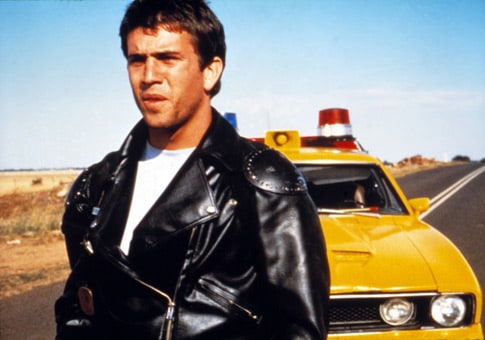Assembled and released at the height of the "Ozploitation" craze of the '70s and '80s, Mad Max was a genuine diamond in the rough, a low-budget dark horse of a movie which developed into a box office smash. Here is a vehemently manly, violent post-apocalyptic action movie notable for the sheer creativity of its construction. The brainchild of George Miller and Byron Kennedy, Mad Max's future world is not full of lavish technology like Blade Runner, instead presenting a bleak, horrifyingly plausible vision of a post-apocalyptic world where the law and order is fading amid pure chaos. It's a movie of eccentric characters, imaginative camerawork, insane action scenes and unique production design, yet it also feels like there's nary a wasted moment - every scene and moment builds to a cohesive whole.

The titular Max Rockatansky (Mel Gibson) is a highway patrolman in the future. Although law enforcement still exists in some capacity, civilisation has essentially deteriorated, giving rise to vicious gangs who run rampant, killing and murdering on a whim. After a high-speed car chase ends with the death of a gang member known as Nightrider (Vincent Neil), his comrades take it upon themselves to track down Max and his buddies in the Main Force Patrol (MFP). Led by a thug who calls himself the Toecutter (Hugh Keays-Byrne), the gang eventually set their sights on Max's family, wife Jessie (Joanne Samuel) and infant son Sprog (Brendan Heath), which ignites a vendetta of vengeance for the MFP officer.
For what is essentially an exploitative action flick, Mad Max is not all about car chases, instead spending a fair amount of time with Max and his family to give the antihero a sympathetic edge before he goes, well, mad. Miller, who co-wrote and directed the picture, develops a tender relationship between Max and Jessie, which gives a spark of genuine intensity to the final third when Max looks to exact revenge on the Toecutter's gang. Miller also imbues the feature with a streak of laconic, dark humour to offset how disturbing this future truly is. Additionally, the often unusual character names (Sprog, Goose, etc.) and the quirky costumes add further texture to this highly peculiar world.

An Australian native, Miller is and always has been a complete lunatic of a moviemaker in the best possible way, consistently pushing the boundaries of what's possible on a budget through dangerous camera gymnastics and insane, high-risk stunts. Without much financing, Miller and director of photography David Eggsby get major plaudits for the sheer ingenuity of the picture - Miller himself even rode on the back of a motorcycle for one shot, and cameras were attached to cars in the most budget-friendly fashion possible. The result is pure dynamite, a feature with an understandably limited scope that still has the power to generate a rare kind of thrill all these years on. In an age of glossy, high-budget blockbusters, Mad Max is exhilarating because everything had to be achieved practically - the thrilling car mayhem was executed by real stuntman putting their lives on the line, not CGI.
As the film was created without major studio backing, post-production for Mad Max took place in a small lounge room, with Miller and his collaborators employing a DIY editing machine. It's a genuinely impressive feat, rendered all the better by the truly superb editing - the dramatic scenes may not be the greatest, but the action sequences are fast and furious. Mad Max was a controversial movie upon release, banned in some territories and heavily cut in others. Yet, in comparison to more recent productions, there is not a great deal of graphic violence here. This is a testament to Miller's skill as a cinematic craftsman; he generates a sense of disturbing brutality through creative editing, aided by the overly melodramatic but nevertheless effective score by Brian May.

Mad Max is notable for introducing the world to a then-unknown actor named Mel Gibson. He looks extremely young here, with a smooth face and bright eyes - he was a mere 21 years of age during principal photography. While Gibson's performance is not as robust here as his work on future projects like Lethal Weapon or Braveheart, he's still a charismatic, masculine presence, and there are emotional underpinnings to his work that makes the story somewhat affecting. Max is the very definition of an antihero, as he needs to jettison every vestige of his humanity and become just as cold and depraved as the Toecutter's gang to bring down the monsters. And speaking of the Toecutter, he's a very colourful villain, played perfectly by Keays-Byrne (who will also be playing the baddie role in 2015's Mad Max: Fury Road). The whole ensemble of bad guys steal the show, from Gill's manic Nightrider to Tim Burns' dim-witted Johnny the Boy. The performance are menacing and animalistic yet also amusing, a rare achievement indeed. Mad Max was notoriously dubbed for the American market, as the distributors were concerned about the Australian accents. Of course, the result of such preposterous efforts remains more of a historical curiosity; the best way to experience this Aussie gem is with its original soundtrack.
Years on, Mad Max endures as an Ozploitation classic elevated by insane car chases and stunts, yet the build-up never quite pays off properly. The climax is badass, to be sure, but you can be forgiven for wanting more. Ultimately, the movie feels like a set up for the superior sequel, Mad Max 2 a.k.a. The Road Warrior, though this doesn't diminish this first instalment's merits.
7.9/10
 Login
Login